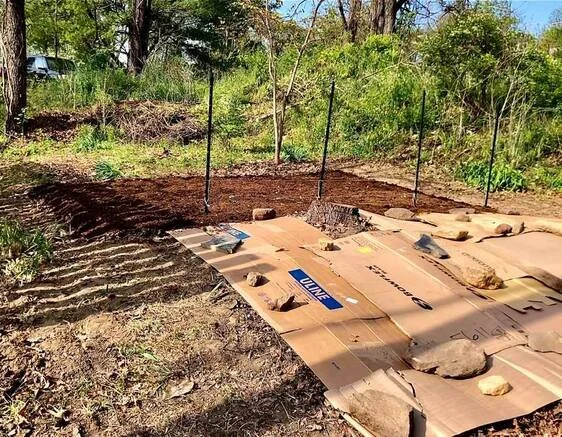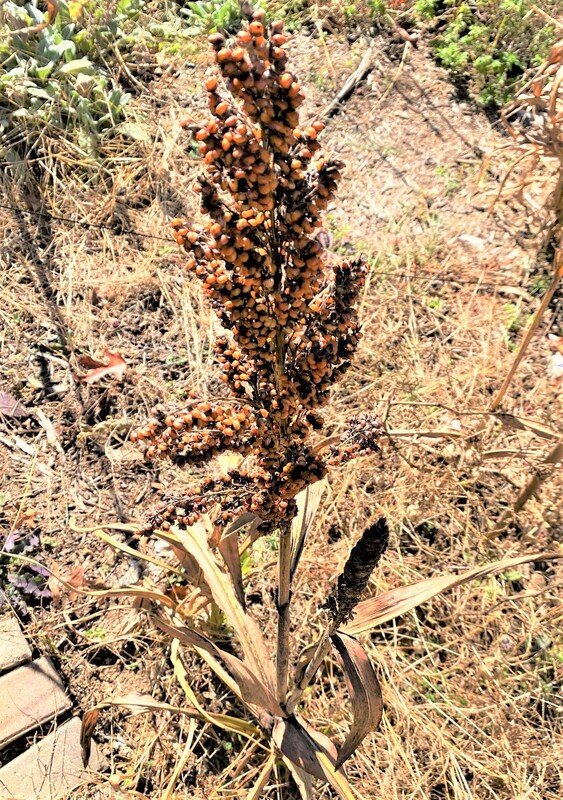The Fall Garden: Alternatives to Pesticides
By Jillian Wolf, Legacy Landscapes, Bee City USA - Asheville Leadership Committee
As colder weather and our first hard frosts open up the landscape to bare bones, it’s the perfect time to prepare for next year’s growing season. Save those leaves!
Prepping for next season begins with supporting our pollinators and other beneficial insects through winter. If we work too hard at cleaning up, they will suffer. Manicured lawns and pristine beds that must be artificially maintained create an artificial environment in which “the good guys” fail to thrive, in particular, the native bees critical to our ecology. It’s a look that we’ve grown to revere, but that is changing. Natural “habitats” are trending!
You can begin by leaving anything alone that is still flowering. Changing weather can be challenging for some species, and fall flowers provide needed nutrition. It’s also important to leave plenty of spent plants standing, as stem-nesting bees need them to continue their life cycle. Stems, branches, canes and reeds provide a variety of accommodations, which is why it’s best to cut your “winter garden” down in late spring. If you must cut now, bundle! Nesting material can be gathered and tied together to hang on a fence or hide in a bush, preferably where there is some weather protection – or just loosely pile it up somewhere safe. For bees and beetles seeking luxury housing, leave downed trees where they fall or incorporate dead logs in the landscape. Ground nesting bees need support as they are some of the first pollinators to spread their magic in the garden each spring. A grassy area kept very short or bare spots in the garden are ideal, especially if they are south-facing.
Recognizing that many of us do love our lawns (for aesthetics or recreation), can we talk about leaves as they turn color and cover our yards? Lawns, of course, will die if the leaves are not raked away, our first clue that leaves are amazing weed blockers! They also provide critical insect habitat. Leaves provide insulation for butterflies and moths (many butterfly chrysalids and moth cocoons look just like leaves!), and in the compost pile they add to a safe haven for hibernating bee queens and other beneficials like earthworms (and redworms, the kings of composting). And oh that compost! Everything from growing your favorite native to sequestering carbon in the fight against climate change starts with the soil. We have our job cut out for us here in Western North Carolina, largely dealing with dense red clay that’s either cracking dry or rotting wet. Fortunately, amendments and weed control go hand in hand, and this is where your leaves come in really handy.
Want to reduce or eliminate the use of pesticides? (Remember, organic controls can kill good guys too!) Fall preparation in the garden requires a bit of forethought but soon moves into second-nature status with practice. In addition to collecting leaves (yours, or your neighbors if you don’t have any), you’ll want to save cardboard. It’s plentiful at recycling centers and in retail dumpsters, but saving your own saves time. Cardboard is useful for covering large areas like a vegetable garden, or your lawn if you’re wanting to extend your beds. For grass, if you dig up and flip the turf first, it will hinder regrowth and provide green mulch for beneficial excavators. Newspapers are also a great way to go. If you are preparing landscaped areas, you can work with ¼” thick stacks of newspaper around established plants.
If weed blocking is your focus, start with those treasured leaves. Whole leaves will mat down in layers to prevent the emergence of weeds and can last through up to two seasons depending on how thick you lay them down. Cover the leaves with cardboard and then compost or mulch. Compost is preferred as it feeds the soil better and is light enough to allow insect activity. If your goal is to create healthy soil as quickly as possible, you can lay the cardboard down first with leaf mulch (chopped up leaves) on top. Leaf mulch breaks down over winter to amend the soil in a single season, blocking weeds during that time. Don’t worry about whether or not leaves are acidic. It’s all good.
A note about man-made bee houses and hotels: they are great educational tools because they allow us to observe nesting bees; however, sometimes they do more harm than good. If made of unsuitable materials and sold with no word about or access for cleaning them, they can harbor pests, disease, mold, and fungus. They also tend to unnaturally aggregate multiple species, at the very least creating a juicy target for predators. Constructed appropriately, they can be useful in gardens too small to otherwise provide habitat.
Gardening in partnership with your garden ecology supports the environment we all depend upon. Pollinators are as critical to maintaining wild areas as they are for pollinating our food (1/3 of everything we eat!). Other beneficial insects prey upon garden pests we’re in the habit of treating with pesticides. The “lasagna method” of weed control described here not only keeps weeds at bay, conserves water and feeds the soil, it attracts the good guys. Nature isn’t as messy as we make it out to be. In our pursuit of a garden aesthetic handed down to us by European royals in the 1700’s, we’ve forgotten to smell anything but the roses. Times have changed and celebrating nature is now not just desirable, but critically important. To help your neighbors understand why you’re going wild in your garden, consider applying for the Pollinator Garden Certification from Asheville GreenWorks’ Bee City USA program. It’s easy! It includes a metal yard sign that not only explains your motives but educates people who are unaware of how important pollinators are.
Fall is the perfect time to plant perennials, shrubs and trees. Recommended species lists and the local nurseries that sell them are available on the Asheville GreenWorks website along with many other useful resources. Get to know more about our native plants and how to utilize them, plant plenty of native flowers, and enjoy!
Now is the perfect time to create the vegetable beds you'll be working next year. Making use of donated materials in this vacant lot will subdue invasives, prep the beds and provide overwintering opportunities for pollinators.
This Sorghum grass is among a number of bird feeder volunteers that will provide seed for birds and a great home for stem nesting pollinators.
American aster is a late-flowering native, providing pollen through early fall. It's a great perennial for use in naturalized areas of your garden, or tucked in among more formal plantings.



